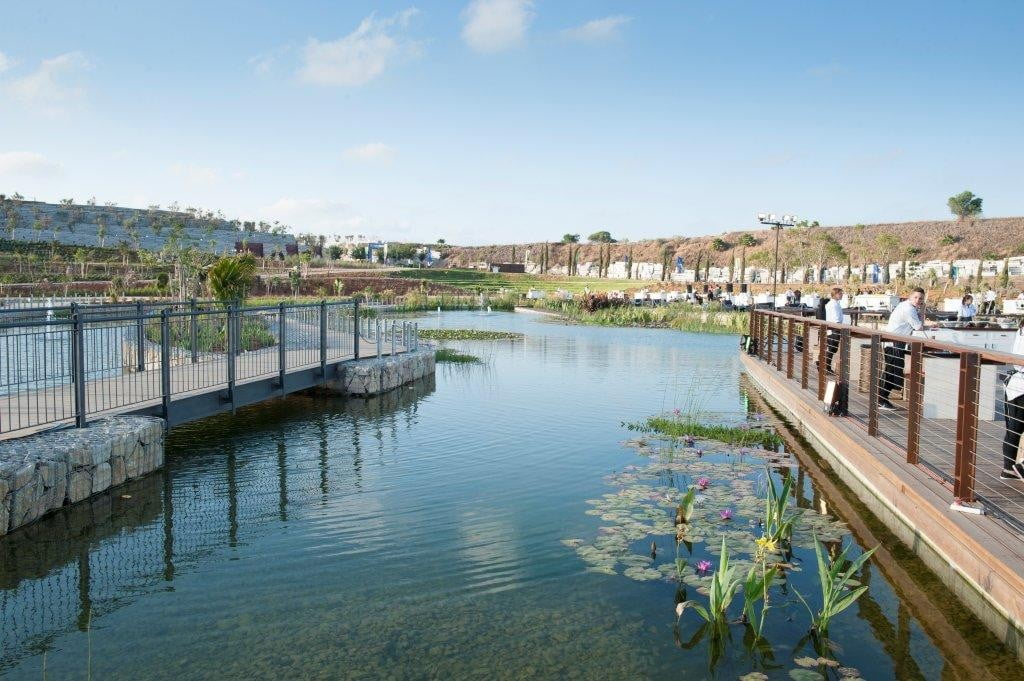Israel’s largest landfill dump has undergone a massive makeover that has seen the mountain of garbage turn into a 2,000-acre ecological park three times the size of New York City’s Central Park. This new “green lung,” which includes a 150-acre recycling station, walking and cycling trails, ponds and extreme sports activities, will soon be home to a 50,000-seat amphitheater, one of the largest concert venues in Israel. And if that’s not enough, the biogas from this landfill, once a toxic pollutant, is now being reused as green energy.
The multi-million-dollar makeover of Hiriya, which started in 2001, has proven to benefit both the surrounding environment and visitors from all over the world. Now, what once was a huge dump between Road 4 and Road 461 in central Israel known for its unpleasant past, is no longer Israel’s ugliest site.
SEE ALSO: Israeli Legislation To Force Clean-Up Of Dump Sites Around The Country
The Cinderella of Tel Aviv: From garbage emerged a thriving garden
Mount Hiriya’s makeover was anything but simple due to the large amount of waste that had to be cleaned up. According to Shay Levi, head of the environmental planning department at the Ariel Sharon Park (formerly known as Hiriya), at its peak in 1998, the park saw 3,000 tons of waste enter on a daily basis. “There was enough garbage on this mountain to fill the Azrieli towers 25 times,” Levi tells NoCamels, referring to the three famous Tel Aviv skyscrapers. The landfill was active from 1952 to 1999, piling up to a total of 450,000 square meters of waste.
Beyond its natural beauty and magnificent views of Tel Aviv, Mount Hiriya serves a recreational purpose for families. The park, which opened to the public in July 2014, has become popular in recent months. It offers various guided tours that explain the rehabilitation process as well as educational recycling activities for kids. On weekends and holidays, the park averages roughly 1,000 visitors a day – and growing.
4,500 tons of waste recycled every day
Next to the park is a recycling center and transfer station. Each day, approximately 800 garbage trucks deposit 3,000 tons of household waste and garden trimmings into the recycling station; and 400 more trucks bring approximately 1,500 tons of construction waste from 18 local municipalities in the area.
The overuse of the Hiriya landfill due to the rapid urbanization of Tel Aviv and its surrounding metro-area created drainage and contamination issues with the surrounding streams, as well as a buildup of toxic biogas. Now, not only is the biogas being cleaned up, it’s also being shipped to a nearby city for use as green energy. This gas is formed through the breakdown of waste, and was trapped between layers of garbage. In order to reduce the gas buildup from years of waste, 80 wells were drilled into the mountain to pump out the gas – and ship it to the the City of Azor, where it’s turned into green energy.
Sign up for our free weekly newsletter
SubscribeSEE ALSO: Israeli Studio Sfog Recycles Your Old Objects To Create New Furniture
Using rainwater to sustain the park’s irrigation system
At Hiriya, precious rainwater is used to hydrate the soil via a man-made aquifer the park’s staff had built inside the mountain, allowing for the reemergence of the natural vegetation. Through various protective layers, the staff has created a clean and pollutant-free body of water that is used to irrigate the park in a process Levi calls “ecological restoration.”
German architect Prof. Peter Latz, who designed the park, also helped to design its sophisticated watering scheme. Following an international architecture competition hosting 14 applicants from Israel and abroad in 20o4, Latz was chosen as the landscape architect of the park. With the help from Latz, a new bioplastic layer was created to solve the biogas issue, while also allowing flora and fauna to grow, rejuvenating the damaged soil.
The Ariel Sharon Park has become one of the largest, most innovative environmental projects the Middle East, and was featured in several environmental publications. According to Levi, many have come to observe and learn from the successes of Hiriya, looking to replicate this initiative in countries such as the U.S., Russia and China.
But while Hiriya Mountain, previously known as “stinky hill,” has come a long way, it’s still far from being completed. The park will continue to expand through 2020, with more recreational and tourist attractions to come. This new “green lung” of central Israel will offer many observation posts, overlooking the Tel Aviv skyline, along with shops and activities hosted by the park in the future.
Photos and video: Ariel Sharon Park, Israel Peled, Dovev, Pil Animation Ltd.
Related posts

Resilient And Nutritious New Plant-Based Milk Aims To Make A Splash

Chocolate From Cultivated Cocoa Comes Without Environmental Toll

Plastic Fantastic: Startup Takes PVC Back To Its Crude Oil Roots







Facebook comments